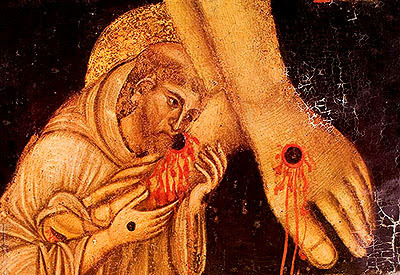Loreto
On the night of the 9th/10th December, Italians in the Marche region of Italy light bonfires; they are meant as beacons and guides for the Holy House of Nazareth as it makes it way through the night sky to find its resting place on the hill of Loreto, up above the city of Ancona. Italians have been observing this custom since 1617, and it looks to the belief that the House of the Holy Family was brought to this site through the ministry of angels to Loreto on the 10th December 1294.
According to tradition, the House, under threat from the Muslim invaders of the Holy Land, as Acre fell in 1291, was taken up from its foundations in Nazareth and transported first to Tersatto (Trsat) in Dalmatia (Croatia) and then, three years later, taken across the Adriatic to a hill in the laurel woods of Recanati. There, resting on a road, without foundations, the House has remained to this day.
For the first time today, the universal Church celebrates the memorial of Our Lady of Loreto on the anniversary of the House's arrival. Pope Francis inscribed the memorial in the General Calendar in October (see the decree here) and Proper texts have been composed and are available in Latin; the texts have yet to be translated. The Second Reading for the Office of Readings is taken from Pope St John Paul II's letter to the sanctuary of Loreto for its seventh centenary in 1993; the Latin text is included in the Proper, the original Italian text can be accessed here. Our Lady of Loreto has been designated the patroness of aviation, so today we pray for all involved in that industry and for all who travel by air
The Lauretan tradition, as it is called, is preserved in a text which defends the authenticity of the House as the actual house where the Annunciation took place and where the Holy Family lived; it also speaks of the House's translation 'by the ministry of angels'. Over the centuries both the origin of the building which stands in Loreto and the means of its being there has examined, questioned, disputed and defended. It was a source of controversy for centuries and divided Catholics. This has led to intensive archaeological and historical research, every inch of the House has been examined and careful excavations undertaken to find evidence of origin and translation. As this historical enquiry has been taking place, the sanctuary remains a place of pilgrimage and spiritual encounter.
That historical and archaeological investigation has yield a vast array of information. It was proved that the House has no foundations, it stands upon an ancient road on a hill. It was originally encased in a brick wall, now known as the Recanati Wall, to protect it - a magnificent marble casing was later added to protect both structures. Numerous items were found in between the bricks, most notably Crusader cloth crosses, confirming that the knights were involved its being brought to Loreto. the House was deemed to from the Middle East, its bricks made of stone from the area around Nazareth. In structure, consisting only of three walls, it conforms to the foundations of the house of the Holy Family in Nazareth. The home of the Holy Family consisted of a brick building built on to a cave - the cave remains and the foundations of the brick building still lie in front of it. Without doubt, the Holy House of Loreto is the house of Nazareth.
Regarding its translation, the legend was found to be false. Documentary evidence revealed that when the final crusader kingdom was about to fall in 1291, fearing for the safety of the House in Nazareth, the building was carefully dismantled, its structure noted, and the bricks were transported to Italy. It seems that, at some stage, they came into the possession or were under the care of a Angeli or Angelos family, and there is some reference to that they may have been part of dowry. The bricks eventually came to Rome during the infamous interregnum in 1292-1294. As there was no pope, no decision should have been made on the destination of the bricks, however, one official from the area of Recanati managed to have the bricks sent to his region and by the end 1294 they had arrived and the House was constructed in the exact manner as it had been in Nazareth.
The House quickly became the focus of pilgrimage; a great church, later raised to the status of a minor basilica, was built around it. Since the foundation of the sanctuary millions of pilgrims have passed through the House, including numerous Saints and Beati whose names are preserved in a monument in the basilica. The sanctuary has become a repository for some of the greatest works of art and its fame was so great that Napoleon made it his business to loot it when he was making his way through Italy - many of works he stole have never been returned.
However, the greatest treasure of all is the sanctuary's spiritual significance, and this is what Pope Francis wishes to emphasise in placing today's feast on the calendar. There are many dimensions to the spirituality of Loreto - the Annunciation, the Incarnation the gestation of the Divine Child, the life of the Holy Family, the Hidden Years, the life, work and death of St Joseph, the life and contemplative prayer of Our Lady, the childhood of Jesus, the life and mystery of the first Christian family, and so much more. Those who have been to Loreto will know that there is an extraordinary presence there, you feel welcomed into the House, and once you are inside you never want to leave. There is always a crowd of people in that small space, and there is there is the most profound silence and calm. It is a place of contemplation and silence, its very stones seem to speak of what they have seen to the pilgrims who seek to meditate on what has happened with those walls.
Next year, 2020, is the centenary of Pope Benedict XV's declaring Our Lady of Loreto patroness of aviation - for this reason the year has been designated a Lauretan Jubilee; it is the perfect year to visit the sanctuary and spend a couple of days in prayer and retreat there. And today is certainly a day we can all enter in spirit as pilgrims into that sacred place. The prayers that are proper to the sanctuary and the feast are the Angelus and the Litany of Loreto (Litany of Our Lady).





Comments
Post a Comment